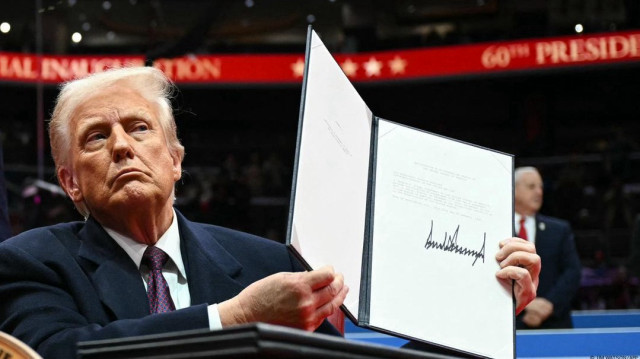
President Donald Trump signs 26 executive orders so far in his 2nd term with Franklin D. Roosevelt leading with 3,721 orders
US President Donald Trump marked his return to office by signing a series of executive orders addressing homeland security, energy, immigration, and the economy, while overturning nearly 80 executive actions of the previous administration.
Executive orders, a vital tool of the US presidency, enable the management of the federal government operations.
These directives stem from Article Two of the Constitution, granting presidents broad authority to enforce laws and manage executive branch resources.
As the nation's head of state, government leader, and commander-in-chief of the Armed Forces, only the president can issue executive orders and they remain in effect until they are revoked, ruled unlawful, or expire.
Executive orders address critical issues such as national security, immigration, and federal administration.
While they bypass congressional approval, these directives must align with constitutional or statutory authority and are subject to judicial review.
- History
Since 1789, all US presidents except William Henry Harrison have issued executive orders, totaling over 13,731.
Franklin D. Roosevelt leads with 3,721 orders, followed by Woodrow Wilson (1,803), Calvin Coolidge (1,203), and Harry S. Truman (907).
Trump issued 220 orders during his first term, while former President Joe Biden has signed 162 in the last four years. As of 0900GMT, Trump has signed 26 executive orders in his second term, according to the Presidency Project of UC Santa Barbara data.
Formal documentation of these directives began in 1907 when the State Department started numbering orders retroactively to 1862. The Federal Register Act of 1936 established more comprehensive recording standards.
- Key differences with other directives
Though all three types of presidential directives—executive orders, political memoranda, and proclamations—are tools for managing federal operations, they differ significantly in their purpose, legal implications, and procedural requirements.
Executive orders carry substantial authority and impact federal policy directly, whereas political memoranda offer informal guidance without strict publication protocols and proclamations serve more ceremonial roles with limited legal effects.
Political memoranda, often referred to simply as memoranda, are similar to executive orders but lack formal issuance processes and are not required to be published in the Federal Register, making them less visible. Despite carrying legal weight, they are primarily used to guide federal agencies on policy implementation.
Presidents may use memoranda for various purposes, including directing agencies on policy matters or outlining administrative procedures without going through the formalities associated with executive orders.
Meanwhile, presidential proclamations serve ceremonial purposes, such as designating special observances or addressing trade policies. Unlike executive orders, proclamations rarely carry enforceable legal weight, functioning instead to raise public awareness or commemorate significant events. They may declare specific days or events, such as National Day of Mourning, or address issues like trade policies.
Hello, the comments you share on our site are a valuable resource for other users. Please respect other users and different opinions. Do not use rude, offensive, derogatory, or discriminatory language.
The floor is all yours.








